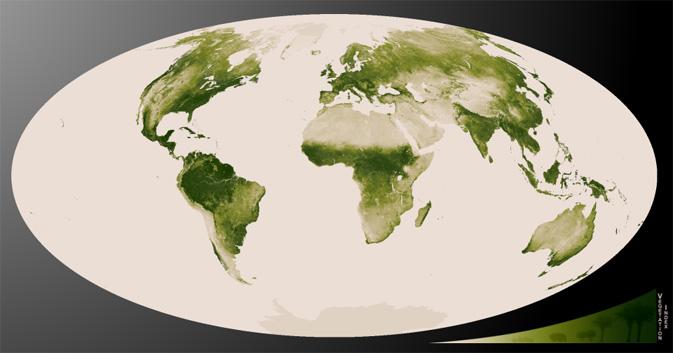
Photo: NASA/NOAA
Humans’ global footprint is becoming increasingly green. Specifically, landscapes that are most heavily dominated by people show the greatest increases in average photosynthetic capacity, or vegetation density, between 1981 and 2010, according to a new study co-authored by University of Maryland and National Socio-Environmental Synthesis Center (SESYNC) researchers.
It may seem counterintuitive that areas of intensive land use—such as dense settlements, villages, and croplands—show steeper increases in greenness than forests and wildlands. But this correlation between people and plants, the researchers say, appears by virtue of land conversion for human use, nitrogen fertilization, and water irrigation.
“Earth's land surface has been changed across very broad scales,” said lead author Thomas Mueller of the University of Maryland (now at the Biodiversity and Climate Research Centre in Frankfurt). “Human intervention has increased the capacity for plants to perform photosynthesis over large areas where intensification of agriculture has occurred.”
The corresponding paper, “Human Land-Use Practices Lead to Global Long-Term Increases in Photosynthetic Capacity,” was published today in Remote Sensing. Its University of Maryland co-authors include Ralph O. Dubayah, George C. Hurtt (also of SESYNC), and William F. Fagan (also of SESYNC).
“The research is novel because it quantifies the global effects of the human footprint on vegetation index trends, and it’s the first global synthesis of photosynthetic capacity using this multi-decade data set,” said Fagan.
The researchers used satellite data collected by NOAA’s Advanced Very High Resolution Radiometers (AVHRR), NASA’s Sea-Viewing Wide Field-of-View Sensor (SeaWiFS), and NASA’s Moderate Resolution Imaging Spectroradiometer (MODIS), which contribute to a vegetation index that allows scientists to create detailed maps of the Earth’s green vegetation density. They used these data to quantify trends and fluctuations in vegetation greenness over large areas, and to estimate the drivers of these changes.
“Global change models typically assume that increased greening is a product of increasing carbon dioxide and temperature,” said Fagan. “What this research suggests is that at least some of the long-term increases in greening have been driven directly by people, rather than indirectly by global atmospheric changes.”
The study follows on the heels of related research that showed the impact of climate on land plants at higher northern latitudes, where winter temperatures restrict the growing season—which researchers called the “warmer Earth, greener north” phenomenon. Agricultural areas were excluded from the higher northern latitude studies.
“We now know that in addition to warmer climate at higher northern latitudes, human land use at lower latitudes also has a detectable, global footprint on Earth's vegetation growth,” said co-author Compton J. Tucker of NASA.
The paper’s co-authors also include Gunnar Dressler of Helmholtz Centre for Environmental Research (UFZ), Jorge E. Pinzon of NASA, Peter Leimgruber of Smithsonian Conservation Biology Institute, and Katrin Böhning-Gaese of Biodiversity and Climate Research Centre.
This work was supported by the National Socio-Environmental Synthesis Center (SESYNC) under funding received from the National Science Foundation DBI-1052875. Access the article at: http://www.mdpi.com/2072-4292/6/6/5717
Media Contact
Melissa Andreychek
mandreychek@sesync.org, 410-919-4990